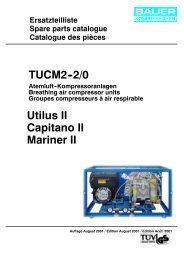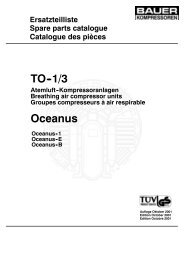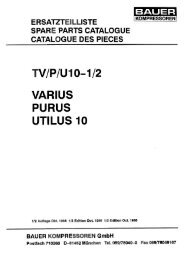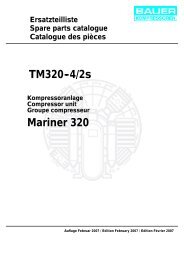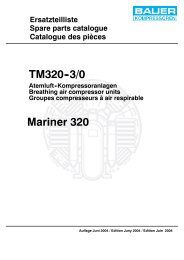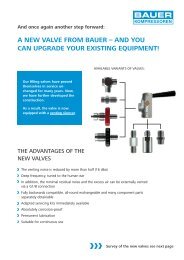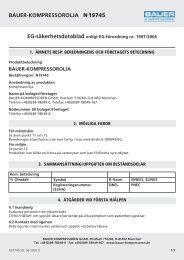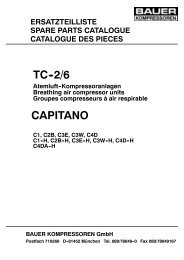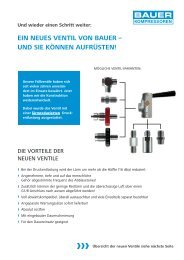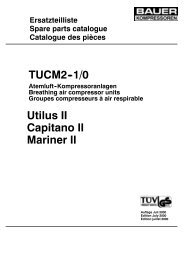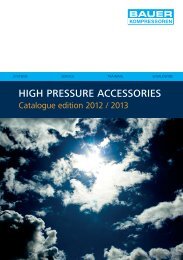Operator's Manual High Pressure Breathing Air Compressors
Operator's Manual High Pressure Breathing Air Compressors
Operator's Manual High Pressure Breathing Air Compressors
Create successful ePaper yourself
Turn your PDF publications into a flip-book with our unique Google optimized e-Paper software.
Operator’s <strong>Manual</strong><br />
12. FURTHER FILLING POSSIBILITIES<br />
12.1. OVERFLOW<br />
<strong>Air</strong> from a cylinder with higher pressure can overflow into a cylinder with lower pressure.<br />
In this way an equilization of pressure is reached.<br />
Filling procedure:<br />
-- Connect donating and receiving cylinder to each other (e.g.: with overflow hose)<br />
-- Unscrew donating cylinder, carefully open receiving cylinder as not to damage the sintered metal filter at the water detector pipe.<br />
-- Equilization of pressure is reached (a complete equilization cannot be reached in this case, as the cylinders warm up or cool down<br />
at a different rate).<br />
-- With several cylinders, couple each donating cylinder with the lowest pressure to the receiving cylinder with the highest pressure<br />
(smallest pressure difference ! ).<br />
12.2. FILLING FROM STORAGE CYLINDERS<br />
When using storage cylinders it is recommended to fill them at the max. permissable operating pressure to reach the optimum usage<br />
of the bottle volume.<br />
CAUTION<br />
If the storage bottles are filled at a pressure higher than 225 bar, then a pressure reducer and an additional final pressure<br />
safety valve are needed to overflow, which avoids a non -permissable high pressure being reached in the cylinders<br />
to be filled.<br />
To make the filling procedure easier and faster, an automatic switching device (part no. 062796--635) can be used. This makes<br />
full use of the advantage of storage cylinders.<br />
The automatic switching device functions as follows:<br />
-- With filled storage cylinders (2), first the air compressed to a higher pressure flows from the storage cylinders via the non--return<br />
valve and filling panel (4) into the compressed air cylinders (see Fig. 36).<br />
-- A pressure reducer in the filling panel ensures that the cylinders to be filled cannot be overfilled.<br />
-- Depending on the volume of the storage cylinders, in this way several cylinders can be filled very quickly (overflow principle).<br />
-- If, after filling several cylinders the storage cylinder pressure has dropped to the min. value set on the pressure switch of the automatic<br />
switcing device, the compressor automatically switches on and fills the cylinders directly (see Fig. 37).<br />
-- If more cylinders are filled, they will be filled directly from the compressor (1) .<br />
-- As soon as no more cylinders are to be filled or when their final pressure has been reached, the pressure maintaining valve opens<br />
and allows the air to flow from the compressor (1) straight into the storage cylinders (2) until they are full and the max. set value<br />
on the pressure switch of the automatic switching device stops the compressor (1) (see Fig. 38) .<br />
-- The same principle can also be used, when the storage cylinders (2) are filled at ”only” 200 bar.<br />
-- Then not as many cylinders can be filled by overflow, however the total filling time is shorter, as quite a lot of air can be taken out<br />
of the storage cylinders (2) (until equilization of pressure has been reached) and the the compressor (1) is automatically switched<br />
on and the residual amount is filled up.<br />
53



